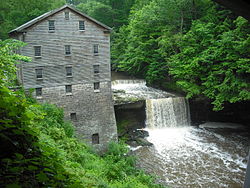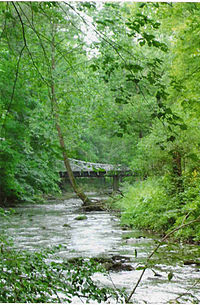- Mill Creek Park
-
For Mill Creek Park, Michigan, see Historic Mill Creek State Park.
Mill Creek Park is a metropolitan park located in Youngstown, Ohio. It is the second largest metropolitan park in the United States after Fairmount Park in Philadelphia[citation needed], and the 140th largest park located within the limits of a U.S. city.[1]
Contents
History
The park was founded in 1891 due to the "untiring efforts of Youngstown attorney Volney Rogers".[2] Rogers secured options on much of the land and was able to purchase large tracts of it. This was no small task given that he was compelled to deal with more than 90 landowners.[3] Once the land was secured, Rogers framed and promoted what he called the "Township Park Improvement Law." Upon the law's passage, Rogers turned over all of the land he had secured for park purposes.[3] Rogers had the area declared a park by the state legislature. It officially opened in 1893.[4]
Rogers later enlisted the help of his brother Bruce, who had studied landscape architecture, and Bruce Rogers became the first Mill Creek Park superintendent.[5] Earlier, the project benefited from the contributions of well-known landscape architect Charles Eliot, and Mill Creek Park is regarded as one of his notable works.[6]
The same year that the park opened, the Mahoning County commissioners issued bonds to pay for the parkland, and Rogers purchased $25,000 of them, with the understanding that they would be the last ones paid. Ironically, the financial panic of 1893 facilitated the park's development. As a later newspaper account observed: "Unemployed men found work there. A second bond issue paid for their wages. The men cut trails, established drives, restored Pioneer Pavilion (a renovated factory building that was the oldest structure in the park) and built Lake Cohasset Dam".[5]
Lanterman's Mill
One of Mahoning County's most historic landmarks, Lanterman's Mill was built in 1845-46 by German Lanterman and Samuel Kimberly. Restored in 1982-85 through a gift from the Ward and Florence Beecher Foundations, this community treasure represents one of the many pioneer industries developed along Mill Creek and operates today as it did in the 1800s, grinding corn, wheat, and buckwheat.
Visit Lanterman's Mill and step into the past. Observe the pioneer ingenuity involved in the early production of meal and flour, smell the sweet aroma of freshly ground grains, and feel the rumbling vibrations of the massive stones as the various grains are ground. Browse the gift shop located in the Mill to find unique items and charming wares made by local artisans. Our stone-ground cornmeal, buckwheat, and whole wheat flour are preservative-free and can be purchased in the gift shop and at local participating stores. Call 330-740-7107 for information regarding our stone-ground flours and meal. Download a brochure for delicious recipes using your Lanterman's Mill products.
Facilites at this area include: • Observation deck overlooking Lanterman's Falls • Covered bridge (located upstream from the Mill) • Restrooms • Hiking trails
The nearby East Gorge Walk and West Gorge Trail offer a dramatic peek into the area's geologic history. Listed in the Mid-America Walking Atlas, the award-winning Gorge Trail is a breathtakingly beautiful two-mile loop along Mill Creek. The trail consists of a boardwalk and is bordered on one side by the stream and on the other side by a massive wall of sandstone.
Lakes, Ponds and Wetlands
Mill Creek Park contains 3 man-made lakes, 1 pond and 1 wetland.
Lake Glacier
Lake Glacier was created in 1906 by the damming of Mill Creek at the "narrows" as it approached the Mahoning River. This 44-acre lake has provided recreational opportunities for many generations. Boating and fishing are permitted in season. Kayaks and pedal boats are available to rent at the Glacier Boathouse on West Glacier Drive. A passenger boat is available for individual rides and group reservations. A barrier-free fishing dock is located along West Glacier Drive. Hikers can access Old Tree Trail and East Glacier Trail.
Lake Newport & Wetlands
In 1924, Alice Baldwin Lewis donated 70 acres of land specifying that part of the land was to be used for creating a lake. Mill Creek meandered through this shallow valley making it a suitable site for a man-made lake. In 1928 a dam was built, creating what is now known as Lake Newport. Lake Newport, the largest of Mill Creek Park's three lakes, offers 60 acres of open water and 40 acres of wetlands. Boating and fishing are permitted in season. A boat launch is located on East Newport Drive. Kayaks and pedal boats are available to rent at the Boathouse on West Newport Drive.
The Newport Wetlands, located at the southern end of the lake, provide habitat for a variety of plants and animals. Visitors can experience this complex web of flora and fauna by walking the Albert E. Davies Wetland Trail, a boardwalk through the wetlands with interpretive signs along the way. Kayakers can explore the wetland habitat through water trails inaccessible from land. Hikers can access West and East Channel and Islands Trails and West Newport Trail.
Lake Cohasset
Lake Cohasset, the oldest of Mill Creek Park's lakes, was built in 1897 and is known for its stately hemlocks. This 28-acre lake offers visitors a secluded place to view wildlife in their natural habitats. Boating and fishing are not permitted on Lake Cohasset. Hikers can access West and East Cohasset Trails to experience this beautiful area.
Lily Pond
Migrating waterfowl and resident goldfish have made this four-acre pond a popular site since 1896. Visitors can enjoy this area by taking The Lily Pond Circle Trail which loops around the pond.
Today
Mill Creek Park now stretches from the near west side of Youngstown to the southern borders of the city and neighboring Boardman township. The park "encompasses approximately 2,600 acres (10.5 km²), 20 mi (32 km) of drives, and 15 mi (24 km) of foot trails"[2] as well as a variety of bridges, ponds, streams, well-tended gardens, and waterfalls.
See also
Notes
- ^ "The 150 Largest City Parks". Trust for Public Land. http://www.tpl.org/content_documents/citypark_facts/ccpe_150_LargestParks_4_2010.pdf. Retrieved May 6, 2010.
- ^ a b "Mill Creek Park Homepage". Mill Creek Metroparks. http://www.millcreekmetroparks.com/. Retrieved 2007-11-09.
- ^ a b "Builders of Youngstown: Volney Rogers". The Youngstown Daily Vindicator. April 7, 1933.
- ^ "Mill Creek Park History". Mahoning Valley Historical Society. http://www.mahoninghistory.org/wdyk21-park.htm. Retrieved 2007-11-09.
- ^ a b The Youngstown Vindicator, Youngstown, Ohio, December 1, 1946
- ^ "The Olmsted Legacy". Olmsted.org. http://www.olmsted.org/index.php?tg=articles&idx=More&topics=46&article=60. Retrieved 2007-11-09.
External links
Categories:- Youngstown, Ohio
- Urban public parks
- National Register of Historic Places in Ohio
- Protected areas of Mahoning County, Ohio
- Parks in Ohio
Wikimedia Foundation. 2010.


